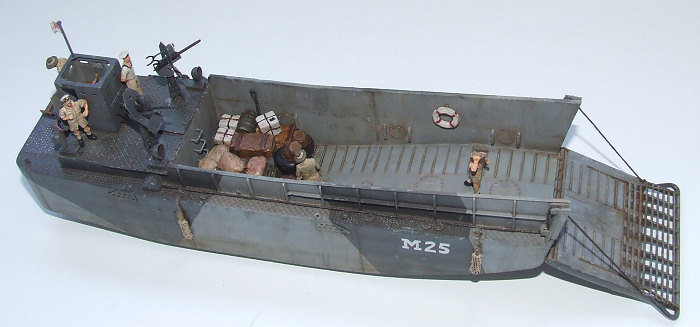
| KIT #: | 7213 |
| PRICE: | AUD$ 22.95 |
| DECALS: | Many options |
| REVIEWER: | Peter Hobbins |
| NOTES: | Allows either USN or RN versions |

| HISTORY |
Developed incrementally from a series of inter-war and early war designs, the landing craft, mechanised (LCM) mark III became a standard assault vessel for the allies from 1942 onwards. These landing craft were standardised for US Navy and Royal Navy production, with minor variations, and were built in the thousands. Able to be carried on the davits of a troopship, the LCM (III) could not only carry a medium tank in its hold; it was also adapted to a multitude of tasks, from bouncing the Rhine full of troops to carting cargo up tiny byways in forgotten corners of the Pacific war.
| THE KIT |
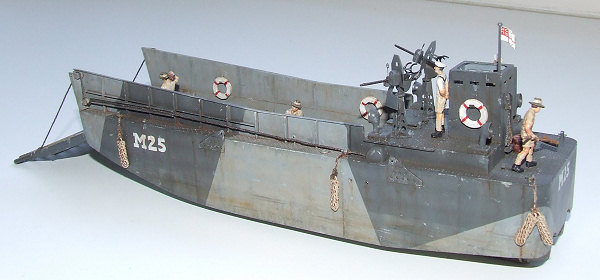 This kit has already been previewed on the site. In brief, it
is well moulded and detailed, and appears to be generally correct dimensionally,
although compared with plans and photographs, it appears to be too deep and the
shape of the propeller channels is incorrectly moulded as semicircular when in
reality they were more akin to truncated ovals. Even though the packaging (and
decals) identify this kit as a US Navy craft, alternative parts are provided for
a British version – including hold ladder and wheelhouse – and these are clearly
called out in the instructions. Detail parts like machine guns and the deck
pattern are very finely moulded, with a small photoetch sheet providing detail
parts for the gun mounts and shields, plus the hoisting attachments on the hull
sides.
This kit has already been previewed on the site. In brief, it
is well moulded and detailed, and appears to be generally correct dimensionally,
although compared with plans and photographs, it appears to be too deep and the
shape of the propeller channels is incorrectly moulded as semicircular when in
reality they were more akin to truncated ovals. Even though the packaging (and
decals) identify this kit as a US Navy craft, alternative parts are provided for
a British version – including hold ladder and wheelhouse – and these are clearly
called out in the instructions. Detail parts like machine guns and the deck
pattern are very finely moulded, with a small photoetch sheet providing detail
parts for the gun mounts and shields, plus the hoisting attachments on the hull
sides.
| CONSTRUCTION |
 On the whole, this kit goes together easily. It is sensibly
engineered and there are only a few ejector pin marks to remove, mostly inside
the wheelhouse. There is also a pour mould indentation on the underside of the
hull that is easy to fill. I did, however, find that the rails that are intended
to be inserted into the bow ramp were short-shot and had to be replaced with
Evergreen rod.
On the whole, this kit goes together easily. It is sensibly
engineered and there are only a few ejector pin marks to remove, mostly inside
the wheelhouse. There is also a pour mould indentation on the underside of the
hull that is easy to fill. I did, however, find that the rails that are intended
to be inserted into the bow ramp were short-shot and had to be replaced with
Evergreen rod.
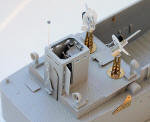
The most problematic area of construction is actually the wheelhouse; assembling the four walls plus the roof to be square and gap-free is not as simple as it could be, requiring a lot of filling and sanding. Once that was achieved, I then found it necessary to shave off some of the mounting platform on the raised deck in order to make the wheelhouse sit flush over the top of it. While the fitting of the deck to the hull is solid, it results in a join line all of the way around the uppersides of the hull that takes a lot of filling and sanding. This then necessitated replacement of the weld seams, achieved by stippling Gunze Mr Surfacer along a thin strip masked off with Tamiya tape.
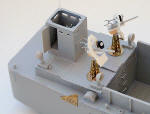 The well deck also assembles cleanly but could do with
better positive alignment aids. I replaced the kit’s moulded ladder rungs with
16-Amp fuse wire to ensure a more rounded profile. While it fits snugly into the
hull cavity, it is difficult to attach the well deck solidly – I applied
superglue at the ends and then joined the longer seams with MEK cement. I found
that the complex and delicate ramp securing mechanism didn’t appear sturdy
enough so I glued it firmly open; the position is probably a little low but
helps achieve a stable display stance for the completed model without recourse
to a separate stand.
The well deck also assembles cleanly but could do with
better positive alignment aids. I replaced the kit’s moulded ladder rungs with
16-Amp fuse wire to ensure a more rounded profile. While it fits snugly into the
hull cavity, it is difficult to attach the well deck solidly – I applied
superglue at the ends and then joined the longer seams with MEK cement. I found
that the complex and delicate ramp securing mechanism didn’t appear sturdy
enough so I glued it firmly open; the position is probably a little low but
helps achieve a stable display stance for the completed model without recourse
to a separate stand.
 This just left the detail parts. The machine gun assemblies
look impressive, but according to references they are incorrect both in shape
and in detail. I fashioned more appropriately shaped armour shields from plastic
card, added mounting rails under the guns, then created the padded armrests from
fusewire. Unfortunately this left the guns sitting higher than in references,
but it would have been very difficult to suitably shorten the etched-brass
mounting pillars. The ventilators were drilled out to provide some depth and the
ramp winches were added on both sides of the hull, although most reference
pictures suggest that there was only one positioned on the port side.
This just left the detail parts. The machine gun assemblies
look impressive, but according to references they are incorrect both in shape
and in detail. I fashioned more appropriately shaped armour shields from plastic
card, added mounting rails under the guns, then created the padded armrests from
fusewire. Unfortunately this left the guns sitting higher than in references,
but it would have been very difficult to suitably shorten the etched-brass
mounting pillars. The ventilators were drilled out to provide some depth and the
ramp winches were added on both sides of the hull, although most reference
pictures suggest that there was only one positioned on the port side.
| COLORS & MARKINGS |
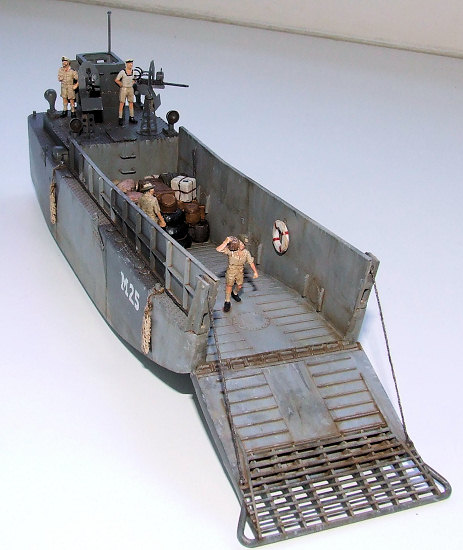 I was inspired to build this model after finding some photos
of an Australian LCM operating off the troopship HMAS Manoora in 1944–45.
I ascertained that it was in a two-tone grey scheme, but could not determine
which shades of grey. I assumed that the lighter colour was a base coat of USN
Haze Gray, then had to judge the tonal value of the darker shade from black and
white photographs. The camouflage pattern was determined with reference to
photos of both LCMs and LCVPs operating off the Manoora. Then came the
fun part.
I was inspired to build this model after finding some photos
of an Australian LCM operating off the troopship HMAS Manoora in 1944–45.
I ascertained that it was in a two-tone grey scheme, but could not determine
which shades of grey. I assumed that the lighter colour was a base coat of USN
Haze Gray, then had to judge the tonal value of the darker shade from black and
white photographs. The camouflage pattern was determined with reference to
photos of both LCMs and LCVPs operating off the Manoora. Then came the
fun part.
Most LCMs showed noticeable ‘bowing’ of the hull plates between the internal bulkheads. This would have been difficult and tedious to achieve during construction, but was more readily achieved with plenty of masking tape. I laid a fine latticework of thin strips following the internal bulkheads (including the undersides), then oversprayed the hull with lightened shades of grey. I removed the masking and sprayed again to lessen the contrast between the masked and faded areas. Then, based on photos, I added a layer of masking at the approximate waterline and sprayed another lightened coat. The ‘M25’ lettering was achieved by scaling up a photograph to create a template, which was then laboriously transferred on to white decal film via lots of scalpel work. The resulting decals were then applied and touched up with white paint – photos show the lettering quite bright even against the tatty hull paintwork. In order to bring out the detail and add a hint of rust, several washes of raw umber oil paint were applied, followed by streaks and smears with pastel dust. I resisted the urge to turn this LCM into a rustbucket, but liberal paint scuffing and chipping was achieved via use of drybrushed light grey paint.
 While the LCM is technically a ship, I’ve always thought of
it as more akin to armour models – probably on account of its angular
construction and relatively small size. As such, I felt it deserved some stowage
and a few figures. The former was achieved via a model railway casting of
various boxes and barrels, while
While the LCM is technically a ship, I’ve always thought of
it as more akin to armour models – probably on account of its angular
construction and relatively small size. As such, I felt it deserved some stowage
and a few figures. The former was achieved via a model railway casting of
various boxes and barrels, while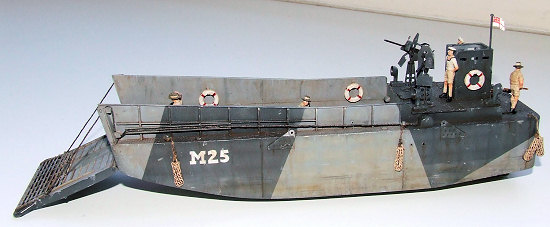 the crew were created by mixing and matching
elements of British 8th Army, Australian infantry and German
Kriegsmarine figures, with uniforms re-carved where necessary to represent
tropical kit. The captain, for instance, is an 8th Army sentry with
the head of a German Kapitan, while the man with the broom was actually an 8th
Army minesweeper with an Australian head added and a scratchbuilt broomhead
replacing his previous technical apparatus! All figures had a pin inserted into
one of their legs, which allowed for a firm attachment via fine holes drilled
into the deck. I then sprayed the finished model with Testors Dullcote and added
the final touch: a White Ensign that came with the ancient Revell 1:720 German
heavy cruiser kits!
the crew were created by mixing and matching
elements of British 8th Army, Australian infantry and German
Kriegsmarine figures, with uniforms re-carved where necessary to represent
tropical kit. The captain, for instance, is an 8th Army sentry with
the head of a German Kapitan, while the man with the broom was actually an 8th
Army minesweeper with an Australian head added and a scratchbuilt broomhead
replacing his previous technical apparatus! All figures had a pin inserted into
one of their legs, which allowed for a firm attachment via fine holes drilled
into the deck. I then sprayed the finished model with Testors Dullcote and added
the final touch: a White Ensign that came with the ancient Revell 1:720 German
heavy cruiser kits!
| CONCLUSIONS |
Trumpeter’s LCM (III) is a nicely moulded although not
entirely dimensionally accurate representation of an important – if mundane –
contributor to the Allied war effort. Construction is n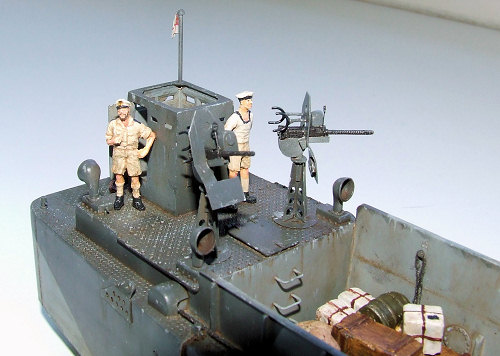 ot
without its problems, but none are insurmountable; it is disappointing that the
machinegun mounts are so incorrect. It is not a hard kit to build, but turning
it into an interesting model almost demands the addition of some crew and a load
– perhaps even one or more vehicles – and it could certainly form the basis for
some fascinating dioramas.
ot
without its problems, but none are insurmountable; it is disappointing that the
machinegun mounts are so incorrect. It is not a hard kit to build, but turning
it into an interesting model almost demands the addition of some crew and a load
– perhaps even one or more vehicles – and it could certainly form the basis for
some fascinating dioramas.
| REFERENCES |
Martin Brice. WW2 Landing Craft. London: ISO Publications, 1985.
Steve Zaloga. ‘Bouncing the Rhine’ in Military Modelling, 6–26 May 2005.
November 2006
Copyright ModelingMadness.com.
If you would like your product reviewed fairly and fairly quickly, please contact the editor or see other details in the Note to Contributors.